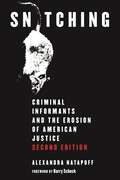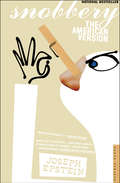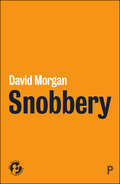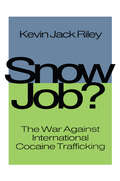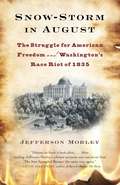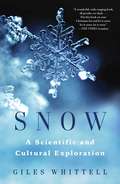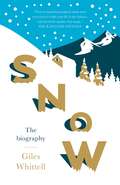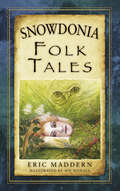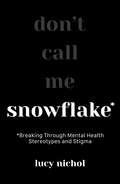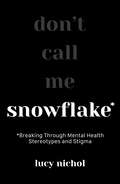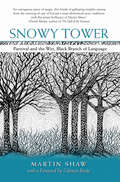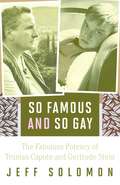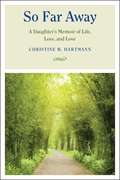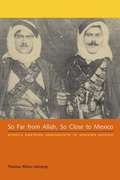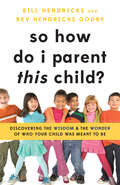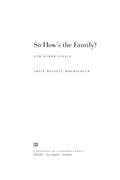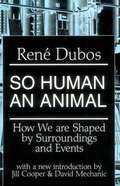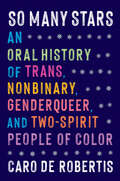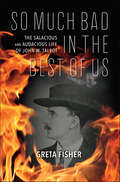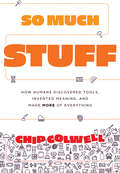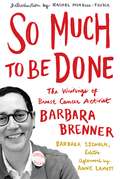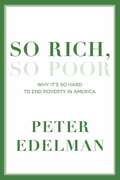- Table View
- List View
Snitching: Criminal Informants and the Erosion of American Justice, Second Edition
by Alexandra NatapoffReveals the secretive, inaccurate, and often violent ways that the American criminal system really worksCurtis Flowers spent twenty-three years on death row for a murder he did not commit. Atlanta police killed 92-year-old Kathryn Johnston during a misguided raid on her home. Rachel Hoffman was murdered at age twenty-three while working for Florida police. Such tragedies are consequences of snitching. Although it is nearly invisible to the public, the massive informant market shapes the American legal system in risky and sometimes shocking ways. Police rely on criminal suspects to obtain warrants, to perform surveillance, and to justify arrests. Prosecutors negotiate with defendants for information and cooperation, offering to drop charges or lighten sentences in exchange. In this book, Alexandra Natapoff provides a comprehensive analysis of this powerful and problematic practice. She shows how informant deals generate unreliable evidence, allow serious criminals to escape punishment, endanger the innocent, and exacerbate distrust between police and poor communities of color. First published over ten years ago, Snitching has become known as the “informant bible,” a leading text for advocates, attorneys, journalists, and scholars. This influential book has helped free the innocent, it has fueled reform at the state and federal level, and it is frequently featured in high-profile media coverage of snitching debacles. This updated edition contains a decade worth of new stories, new data, new legislation and legal developments, much of it generated by the book itself and by Natapoff’s own work. In clear, accessible language, the book exposes the social destruction that snitching can cause in heavily-policed Black neighborhoods, and how using criminal informants renders our entire penal process more secretive and less fair. By delving into the secretive world of criminal informants, Snitching reveals deep and often disturbing truths about the way American justice really works.
Snobbery: The American Version
by Joseph EpsteinObservations on the many ways we manage to look down on others, from &“a writer who can make you laugh out loud on every third page&” (The New York Times Book Review). Snobs are everywhere. At the gym, at work, at school, and sometimes even lurking in your own home. But how did we, as a culture, get this way? With dishy detail, Joseph Epstein skewers all manner of elitism as he examines how snobbery works, where it thrives, and the pitfalls and perils in thinking you&’re better than anyone else. Offering arch observations on the new footholds of snobbery, including food, fashion, high-achieving children, schools, politics, being with-it—whatever &“it&” is—name-dropping, and much more, Epstein explores the shallows and depths of a concept that has become part of our everyday lives . . . for better or worse. &“Smart, witty, perceptive . . . and almost always—in the best sense of the word—entertaining,&” Snobbery provides the ultimate social commentary on arrogance in America (TheWashington Post Book World). It&’s a book you shouldn&’t be caught dead without.
Snobbery: The practices of distinction (21st Century Standpoints)
by David MorganSnobbery is a more serious matter than some may think: the arguments around Brexit and Trump show that accusations of snobbery have become part of political discourse and public sentiment, building social divisions and reflecting deeper issues of class inequality. Social class is not simply about wealth, health and life-chances but also about everyday social experience, such as being included or excluded. As social inequality grows, snobbery is becoming ever more pertinent. This book takes a fresh and engaging look at this key issue, drawing on literature, popular culture and autobiography as well as sociology and history. David Morgan explores the complex history and different varieties of snobbery as well as its all-pervasive character to reveal why, despite claims about the openness of our society, it is still a matter of public concern.
Snow Job: The War Against International Cocaine Trafficking
by Kevin Jack RileyCocaine has had a long and prominent position in the history of American substance abuse. As far back as the late 1800s cocaine was commonly found hi patent medicines, elixirs, and, astonishingly, in the earliest versions of Coca-Cola. Eventually, the potency of cocaine was recognized and its purveyors came under gradual regulation. Events hi the early 1900s kept cocaine use down until World War II, but the extensive drug use of the 1960s once again sparked a national temperance movement. Created in 1989, the Office of National Drug Control Policy maintains responsibility for coordinating and monitoring the nation's countemarcotics policy. But responsibility for coordination and monitoring is not the same thing as control.In Snow Job? Kevin Jack Riley examines source country control policies—policies intended to control the production and export of cocaine from Latin America—and their limitations. Part I draws together drug use, drug production, and drug control policies hi an analytic framework. It goes on to examine the recent history of U.S. drug control policies, source country control policies, the ways hi which cocaine prices affect cocaine use, how cocaine is made, and the vulnerable points in its production. Part II examines the economic effects that production and controls exert on the sources of cocaine—Bolivia and Peru—and probes the Colombian drug lord connection. Part III prescribes an appropriate path for source country cocaine policies and examines their implications for two other widely smuggled drugs, heroin and marijuana.Riley disagrees with analysts who believe that source country control policies can lead to permanent victory hi the war against cocaine, because of the potentially high costs associated with implementing source country control policies on a large scale. He suggests a better strategy would be one that recognizes the severe limits facing interdiction, eradication, and other source country policies, and instead focuses on directing source country resources where they will be most useful. This necessitates defining a regional strategy that elevates political stability and institution building, and demotes traditional countemarcotics objectives. Snow Job? offers original thinking and practical approaches to a multidimensional world problem and will be of interest to policymakers, political scientists, sociologists, and law enforcement officials.
Snow-Storm in August: Washington City, Francis Scott Key, and the Forgotten Race Riot of 1835
by Jefferson MorleyA gripping narrative history of the explosive events that drew together Francis Scott Key, Andrew Jackson, and an 18-year-old slave on trial for attempted murder. In 1835, the city of Washington pulsed with change. As newly freed African Americans from the South poured in, free blacks outnumbered slaves for the first time. Radical notions of abolishing slavery circulated on the city's streets, and white residents were forced to confront new ideas of what the nation's future might look like.On the night of August 4th, Arthur Bowen, an eighteen-year-old slave, stumbled into the bedroom where his owner, Anna Thornton, slept. He had an ax in the crook of his arm. An alarm was raised, and he ran away. Word of the incident spread rapidly, and within days, Washington's first race riot exploded, as whites fearing a slave rebellion attacked the property of the free blacks. Residents dubbed the event the "Snow-Storm," in reference to the central role of Beverly Snow, a flamboyant former slave turned successful restaurateur, who became the target of the mob's rage.In the wake of the riot came two sensational criminal trials that gripped the city. Prosecuting both cases was none other than Francis Scott Key, a politically ambitious attorney famous for writing the lyrics to "The Star-Spangled Banner," who few now remember served as the city's district attorney for eight years. Key defended slavery until the twilight's last gleaming, and pandered to racial fears by seeking capital punishment for Arthur Bowen. But in a surprise twist his prosecution was thwarted by Arthur's ostensible victim, Anna Thornton, a respected socialite who sought the help of President Andrew Jackson.Ranging beyond the familiar confines of the White House and the Capitol, Snow-Storm in August delivers readers into an unknown chapter of American history with a textured and absorbing account of the racial secrets and contradictions that coursed beneath the freewheeling capital of a rising world power."Snow-Storm in August is the sort of book I most love to read: history so fresh it feels alive, yet introducing me to a time and place that I had little known or utterly misunderstood. After reading Jefferson Morley's vibrant account, one can never hear 'The Star-Spangled Banner' the same way again."--David Maraniss, author of Barack Obama: The StoryFrom the Hardcover edition.
Snow: A Scientific and Cultural Exploration
by Giles WhittellBrimming with interesting facts and surprising anecdotes, this scientific and cultural history opens our eyes to the wonders of one of nature&’s most delicate, delightful, and deadly phenomena: SNOW! Perfect for fans of The Hidden Life of Trees and Rain.Go on an extraordinary journey across centuries and continents to experience the wonders of snow; from the prehistoric humans that trekked and even skied across it tens of thousands of years ago to the multi-billion-dollar industry behind our moving, making, and playing with snow. Blending accessible writing with fascinating science, Giles Whittell explores how snow dictates where we live, provides us with drinking water, and has influenced countless works of art and more. Whittell also uncovers compelling mysteries of this miraculous substance, such as why avalanches happen, how snow saved a British prime minister&’s life, where the legend of the yeti comes from, and the terrifying truth behind the opening ceremony of the 1960 winter Olympics. Filled with in-depth research and whip-smart prose, Snow is an eye-opening and charming book that illuminates one of the most magnificent wonders of nature.
Snow: The biography
by Giles Whittell**The Financial Times' Travel Book of the Year 2018** How many snowflakes does it take to build a snowman? Where is the snowiest place on Earth? When will the last snowflake fall? Snow has a lot in common with religion. It comes from heaven. It changes everything. It creates an alternative reality and brings on irrational behaviour in humans. But unlike most religions, snow has never had a bible, until now. Giles Whittell, a passionate snow enthusiast, takes the reader on a quest through centuries and continents to reveal the wonders of snow. Along the way he uncovers the mysteries of snow crystal morphology, why avalanches happen, how snow saved a British prime minister’s life, and the terrifying truth about the opening ceremony of the 1960 winter Olympics. The Secret Life of Snow is the next best thing to a white Christmas, an anthropology and travelogue for everyone from ski addicts to the millions of people who have never even seen it.
Snowdonia Folk Tales (Folk Tales)
by Eric Maddern Sue MynallNorth-west Wales – Old Gwynedd – is one of the most mythic parts of Britain and has some stories whose roots go back more than 2,000 years. Some, like ‘Blodeuwedd, the Woman of Flowers’, feature in the Mabinogion. Others like the story of ‘Merlin and the Dragons’ were written by Geoffrey of Monmouth in the first bestseller of all time (after the Bible), the History of the Kings of Britain. Eric Maddern retells these ancient classics in a fresh, contemporary style. He also includes lesser-known tales from Ynys Môn (the island known as Mâm Cymru, ‘Mother of Wales’), once the heartland of the Druids (like ‘The Story of the Druid Prince’) and the majestic mountains of Snowdonia (Marged Ferch Ifan, ‘the Welsh Amazon’).
Snowflake: Breaking Through Mental Health Stereotypes and Stigma
by Lucy Nichol'Sensitively and seriously exploring mental health stereotypes' StylistThis is NOT a book of rules or statistics. It will NOT tell you what you can and can't say to someone with a mental health problem – or to anyone for that matter. It WILL increase your understanding and empower you to stop stigma in its tracks.Take a deep-dive into some of the most harmful mental health stereotypes with mental health advocate and author Lucy Nichol. Lucy exposes 10 of the most harmful mental health stereotypes and explores the impact of social media, the power of the press and how mental health is represented in popular culture. With the help of experts and the voices of those affected by these harmful perspectives, Lucy makes a case for how we can dismantle stigma once and for all.Foreword by Sue Baker OBE. Contributors include: Natasha Devon MBE, Jonny Benjamin MBE, Hope Virgo, Cara Lisette and Dr Craig Malkin.
Snowflake: Breaking Through Mental Health Stereotypes and Stigma
by Lucy Nichol'Sensitively and seriously explores mental health stereotypes' StylistThis is NOT a book of rules or statistics.It will NOT tell you what you can and can’t say to someone with a mental health problem – or to anyone for that matter.It WILL increase your understanding and empower you to stop stigma in its tracks.Take a deep-dive into some of the most harmful mental health stereotypes with mental health advocate and author Lucy Nichol.Lucy exposes 10 of the most harmful mental health stereotypes and explores the impact of social media, the power of the press and how mental health is represented in popular culture.With the help of experts and the voices of those affected by these harmful perspectives, Lucy makes a case for how we can dismantle stigma once and for all.Foreword by Sue Baker OBE. Contributors include: Natasha Devon MBE, Jonny Benjamin MBE, Hope Virgo, Cara Lisette and Dr Craig Malkin.
Snowflake: Breaking Through Mental Health Stereotypes and Stigma
by Lucy Nichol'Sensitively and seriously explores mental health stereotypes' StylistThis is NOT a book of rules or statistics.It will NOT tell you what you can and can’t say to someone with a mental health problem – or to anyone for that matter.It WILL increase your understanding and empower you to stop stigma in its tracks.Take a deep-dive into some of the most harmful mental health stereotypes with mental health advocate and author Lucy Nichol.Lucy exposes 10 of the most harmful mental health stereotypes and explores the impact of social media, the power of the press and how mental health is represented in popular culture.With the help of experts and the voices of those affected by these harmful perspectives, Lucy makes a case for how we can dismantle stigma once and for all.Foreword by Sue Baker OBE. Contributors include: Natasha Devon MBE, Jonny Benjamin MBE, Hope Virgo, Cara Lisette and Dr Craig Malkin.
Snowy Tower
by Coleman Barks Martin ShawIn Snowy Tower, Dr. Martin Shaw continues his trilogy of works on the relationship between myth, wilderness, and a culture of wildness. In this second book, he gives a telling of the Grail epic Parzival. Claiming it as a great trickster story of medieval Europe, he offers a deft and erudite commentary, with topics ranging from climate change and the soul to the discipline of erotic consciousness, from the hallucination of empire to a revisioning of the dark speech of the ancient bards. Ingrained in the very syntax of Snowy Tower is an invocation of what Shaw calls 'wild mythologies' -- stories that are more than just human allegory, that seem to brush the winged thinking of owl, stream, and open moor. This daring work offers a connection to the genius of the margins; that the big questions of today will not be solved by big answers, but by the myriad of associations that both myth and wilderness offer.
So Famous and So Gay: The Fabulous Potency of Truman Capote and Gertrude Stein
by Jeff SolomonGertrude Stein (1874–1946) and Truman Capote (1924–1984) should not have been famous. They made their names between the Oscar Wilde trial and Stonewall, when homosexuality meant criminality and perversion. And yet both Stein and Capote, openly and exclusively gay, built their outsize reputations on works that directly featured homosexuality and a queer aesthetic. How did these writers become mass-market celebrities while other gay public figures were closeted or censored? And what did their fame mean for queer writers and readers, and for the culture in general? Jeff Solomon explores these questions in So Famous and So Gay.Celebrating lesbian partnership, The Autobiography of Alice B. Toklas was published in 1933 and rocketed Stein, the Jewish lesbian intellectual avant-garde American expatriate, to international stardom and a mass-market readership. Fifteen years later, when Capote published Other Voices, Other Rooms, a novel of explicit homosexual sex and love, his fame itself became famous. Through original archival research, Solomon traces the construction and impact of the writers&’ public personae from a gay-affirmative perspective. He historically situates author photos, celebrity gossip, and other ephemera to explain how Stein and Capote expressed homosexuality and negotiated homophobia through the fleeting depiction of what could not be directly written—maneuvers that other gay writers such as Gore Vidal, Tennessee Williams, and James Baldwin could not manage at the time. Finally So Famous and So Gay reveals what Capote&’s and Stein&’s debuts, Other Voices, Other Rooms and Three Lives, held for queer readers in terms of gay identity and psychology—and for gay authors who wrote in their wake.
So Far Away: A Daughter's Memoir of Life, Loss, and Love
by Christine W. HartmannChristine Hartmann's mother valued control above all else, yet one event appeared beyond her command: the timing of her own death. Not to be denied there either, two decades in advance Irmgard Hartmann chose the date on which to end her life. And her next step was to tell her daughter all about it. For twenty years, Irmgard maintained an unwavering goal, to commit suicide at age seventy. She managed her chronic hypertension, stayed healthy and active, and lived life to the fullest. Meanwhile, Christine fought desperately against the decision. When Irmgard wouldn't listen, the only way to remain part of her life was for Christine to swallow her mother's plans--hook, line, and sinker.Christine's father, as it turned out, prepared too slowly for old age. Before he had made any decision, fate disabled him through a series of strokes. Confined to a nursing home, severely impaired by dementia and frustrated by his circumstances, his life epitomized the predicament her mother wanted to avoid. So Far Away gives us an intimate view of a person interacting with and reacting to her parents at the ends of their lives. In a richly detailed, poignant story of family members' separate yet interwoven journeys, it underscores the complexities and opportunities that life presents each one of us.
So Far Away: A Daughter's Memoir of Life, Loss, and Love
by Christine W. HartmannChristine Hartmann's mother valued control above all else, yet one event appeared beyond her command: the timing of her own death. Not to be denied there either, two decades in advance Irmgard Hartmann chose the date on which to end her life. And her next step was to tell her daughter all about it. For twenty years, Irmgard maintained an unwavering goal, to commit suicide at age seventy. She managed her chronic hypertension, stayed healthy and active, and lived life to the fullest. Meanwhile, Christine fought desperately against the decision. When Irmgard wouldn't listen, the only way to remain part of her life was for Christine to swallow her mother's plans--hook, line, and sinker. Christine's father, as it turned out, prepared too slowly for old age. Before he had made any decision, fate disabled him through a series of strokes. Confined to a nursing home, severely impaired by dementia and frustrated by his circumstances, his life epitomized the predicament her mother wanted to avoid.So Far Away gives us an intimate view of a person interacting with and reacting to her parents at the ends of their lives. In a richly detailed, poignant story of family members' separate yet interwoven journeys, it underscores the complexities and opportunities that life presents each one of us.
So Far from Allah, So Close to Mexico
by Theresa Alfaro-VelcampMiddle Eastern immigration to Mexico is one of the intriguing, untold stories in the history of both regions. In So Far from Allah, So Close to Mexico , Theresa Alfaro-Velcamp presents the fascinating findings of her extensive fieldwork in Mexico as well as in Lebanon and Syria, which included comprehensive data collection from more than 8,000 original immigration cards as well as studies of decades of legal publications and the collection of historiographies from descendents of Middle Eastern immigrants living in Mexico today. Adding an important chapter to studies of the Arab diaspora, Alfaro-Velcamp's study shows that political instability in both Mexico and the Middle East kept many from fulfilling their dreams of returning to their countries of origin after realizing wealth in Mexico, in a few cases drawing on an imagined Phoenician past to create a class of economically powerful Lebanese Mexicans. She also explores the repercussions of xenophobia in Mexico, the effect of religious differences, and the impact of key events such as the Mexican Revolution. Challenging the post-revolutionary definitions of mexicanidad and exposing new aspects of the often contradictory attitudes of Mexicans toward foreigners, So Far from Allah, So Close to Mexico should spark timely dialogues regarding race and ethnicity, and the essence of Mexican citizenship.
So How Do I Parent THIS Child?: Discovering the Wisdom and the Wonder of Who Your Child Was Meant to Be
by Bill Hendricks Bev Hendricks GodbyParents don&’t determine who their kids become. They steward them into who they&’re meant to be.One of the most common myths in parenting books—you see it everywhere—is that parents are responsible for who their children turn out to be. Proper input yields proper output, or so the thinking goes. But that mindset works with machinery, not people. The truth is, your child has a unique set of traits—their giftedness—that only they possess. The parent&’s job isn&’t to crank out a product, but to point an individual human being toward a healthy, flourishing life.In So How Do I Parent THIS Child?, brother and sister duo Bill Hendricks and Bev Hendricks Godby team up to help you understand the difference between producing a product and parenting a person. They take you through all the stages of child rearing—from diapers to driver&’s licenses to diplomas—to give you a comprehensive look at how identifying giftedness and helping your children discover it for themselves makes all the difference.As a parent, you&’ve got a lot of challenges ahead. But with intentionality and an individualized approach, you&’ll see your kids grow up to become the mature and confident adults that they&’re intended to be.
So How Do I Parent THIS Child?: Discovering the Wisdom and the Wonder of Who Your Child Was Meant to Be
by Bill Hendricks Bev Hendricks GodbyParents don&’t determine who their kids become. They steward them into who they&’re meant to be.One of the most common myths in parenting books—you see it everywhere—is that parents are responsible for who their children turn out to be. Proper input yields proper output, or so the thinking goes. But that mindset works with machinery, not people. The truth is, your child has a unique set of traits—their giftedness—that only they possess. The parent&’s job isn&’t to crank out a product, but to point an individual human being toward a healthy, flourishing life.In So How Do I Parent THIS Child?, brother and sister duo Bill Hendricks and Bev Hendricks Godby team up to help you understand the difference between producing a product and parenting a person. They take you through all the stages of child rearing—from diapers to driver&’s licenses to diplomas—to give you a comprehensive look at how identifying giftedness and helping your children discover it for themselves makes all the difference.As a parent, you&’ve got a lot of challenges ahead. But with intentionality and an individualized approach, you&’ll see your kids grow up to become the mature and confident adults that they&’re intended to be.
So How’s the Family?
by Arlie Russell HochschildIn this new collection of thirteen essays, Arlie Russell Hochschild--author of the groundbreaking exploration of emotional labor, The Managed Heart and The Outsourced Self--focuses squarely on the impact of social forces on the emotional side of intimate life.From the "work" it takes to keep personal life personal, put feeling into work, and empathize with others; to the cultural "blur" between market and home; the effect of a social class gap on family wellbeing; and the movement of care workers around the globe, Hochschild raises deep questions about the modern age. In an eponymous essay, she even points towards a possible future in which a person asking "How's the family?" hears the proud answer, "Couldn't be better."
So Human an Animal: How We Are Shaped by Surroundings and Events
by René DubosIn this collection of stories, the bizarre is rendered normal, the absurd hilarious and the incredible comprehensible. The re-imaginations of reality feature evocations of historical figures, over-televised game show hosts and late-night comedians.<P><P> Pulitzer Prize Winner
So Many Stars: An Oral History of Trans, Nonbinary, Genderqueer, and Two-Spirit People of Color
by Caro De RobertisFrom the acclaimed novelist, a first-of-its-kind, deeply personal, and moving oral history of a generation of trans and gender nonconforming elders of color—from leading activists to artists to ordinary citizens—who tell their own stories of breathtaking courage, cultural innovations, and acts of resistance.So Many Stars knits together the voices of trans, nonbinary, genderqueer, and two-spirit elders of color as they share authentic, intimate accounts of how they created space for themselves and their communities in the world. This singular project collects the testimonies of twenty elders, each a glimmering thread in a luminous tapestry, preserving their words for future generations—who can more fully exist in the world today because of these very trailblazers. De Robertis creates a collective coming-of-age story based on hundreds of hours of interviews, offering rare snapshots of ordinary life: kids growing up, navigating family issues and finding community, coming out and changing how they identify over the years, building movements and weathering the AIDS crisis, and sharing wisdom for future generations. Often narrating experiences that took place before they had the array of language that exists today to self-identify beyond the gender binary, this generation lived through remarkable changes in American culture, shaped American culture, and yet rarely takes center stage in the history books. Their stories feel particularly urgent in the current political moment, but also remind readers that their experiences are not new, and that young trans and nonbinary people today belong to a long lineage. The anecdotes in these pages are riveting, joyful, heartbreaking, full of personality and wisdom, and artfully woven together into one immersive narrative. In De Robertis&’s words, So Many Stars shares &“behind-the-scenes tales of what it meant—and still means—to create an authentic life, against the odds.&”
So Much Bad in the Best of Us: The Salacious and Audacious Life of John W. Talbot
by Greta FisherFrom supreme president to forgotten enemy, John W. Talbot lived a remarkable life. Charismatic, energetic, and powerful, he founded a national fraternal organization, the Order of Owls, and counted senators, congressmen, and business leaders among his friends. He wielded his influence to help causes close to his heart but also to bring down those who stood against him.In So Much Bad in the Best of Us, Greta Fisher's careful research reveals that Talbot was capable of great evil, causing one woman to describe him as "the Devil Incarnate." His string of very public affairs revealed his strange sexual preferences and violent tendencies, and charges leveled against him included perjury, blackmail, jury tampering, slander, libel, misuse of the mail, assault with intent to kill, and White slavery. Ultimately convicted on the slavery charge, he spent several years in Leavenworth penitentiary and eventually lost everything, including control of the Order of Owls. His descent into alcoholism and death by fire was a fitting end to a tumultuous and dramatic life. After 50 years of newspaper headlines and court battles, Talbot's death made national news, but with more enemies than friends and estranged from his family, he was ultimately forgotten.A gripping true crime story, So Much Bad in the Best of Us offers a mesmerizing account of the life of John W. Talbot, the Order of Owls, and how quickly the powerful can fall.
So Much Stuff: How Humans Discovered Tools, Invented Meaning, and Made More of Everything
by Chip ColwellHow humans became so dependent on things and how this need has grown dangerously out of control. Over three million years ago, our ancient ancestors realized that rocks could be broken into sharp-edged objects for slicing meat, making the first knives. This discovery resulted in a good meal, and eventually changed the fate of our species and our planet. With So Much Stuff, archaeologist Chip Colwell sets out to investigate why humankind went from self-sufficient primates to nonstop shoppers, from needing nothing to needing everything. Along the way, he uncovers spectacular and strange points around the world—an Italian cave with the world’s first known painted art, a Hong Kong skyscraper where a priestess channels the gods, and a mountain of trash that rivals the Statue of Liberty. Through these examples, Colwell shows how humanity took three leaps that led to stuff becoming inseparable from our lives, inspiring a love affair with things that may lead to our downfall. Now, as landfills brim and oceans drown in trash, Colwell issues a timely call to reevaluate our relationship with the things that both created and threaten to undo our overstuffed planet.
So Much to Be Done: The Writings of Breast Cancer Activist Barbara Brenner
by Barbara Brenner&“What kind of cancer is it?&” was the first question Barbara Brenner asked her doctor after hearing that the lump in her breast was malignant. His answer: &“You don't need to know that.&” Wrong response. Brenner, who was already an activist, made knowing her business and spreading knowledge her mission. The power behind Breast Cancer Action® and its transformative Think Before You Pink campaign, Barbara Brenner brought an abundance of wit, courage, and clarity to the cause and forever changed the conversation. What had been construed as an individual crisis could now be seen for what it was: a pressing concern of public health and social justice, with environmental issues at the center of prevention efforts.Collected in So Much to Be Done, and framed by personal accounts of Barbara and her influential work, Brenner&’s columns and blog posts form a chronicle of breast cancer research and health care activism that is as inspiring as it is informative. As she takes on the corporate forces at work in breast cancer research and treatment and in the &“pinkwashing&” of fund-raising for the cause, Brenner, a self-described hell-raiser, contends with cancer herself, twice, and her words offer understanding and encouragement to all those whose lives are touched by the disease.When Brenner was diagnosed with ALS in 2011, she broadened her critique of health care while also writing about her own experience. Infused with her characteristic moxie, humor, anger, and compassion, these reflections from her last two years provide an in-depth, precisely observed portrayal of what it is to live with a terminal disease and to die on one&’s own terms.
So Rich, So Poor: Why It's So Hard to End Poverty in America
by Peter EdelmanThe author slashes through the myths of poverty and welfare in America, to highlight what has changed since the "War on Poverty" of Lyndon Johnson, and what doesn't work and why.
